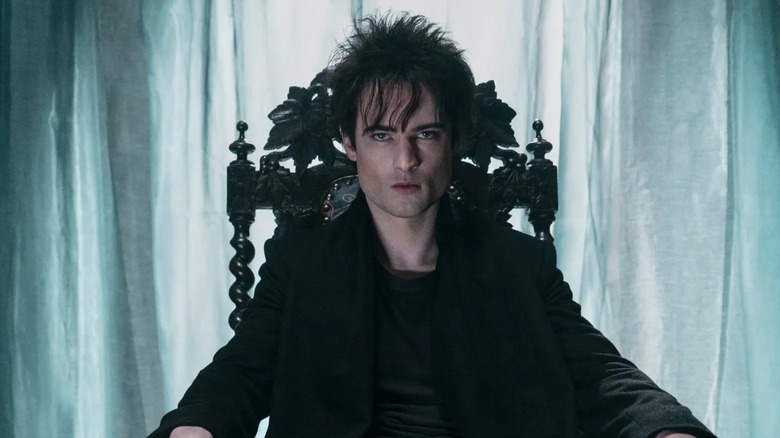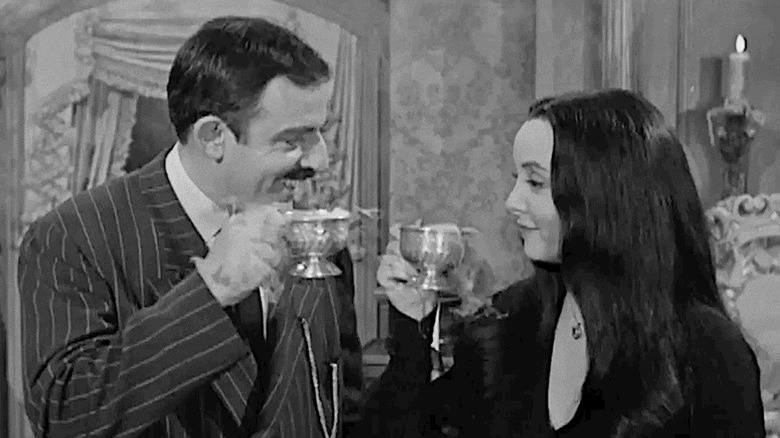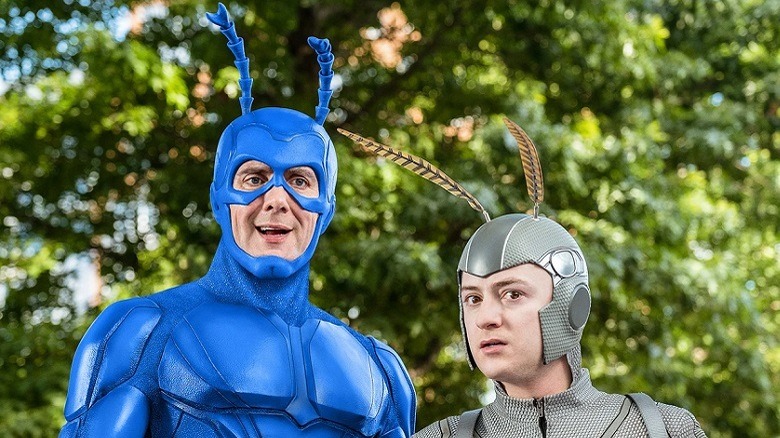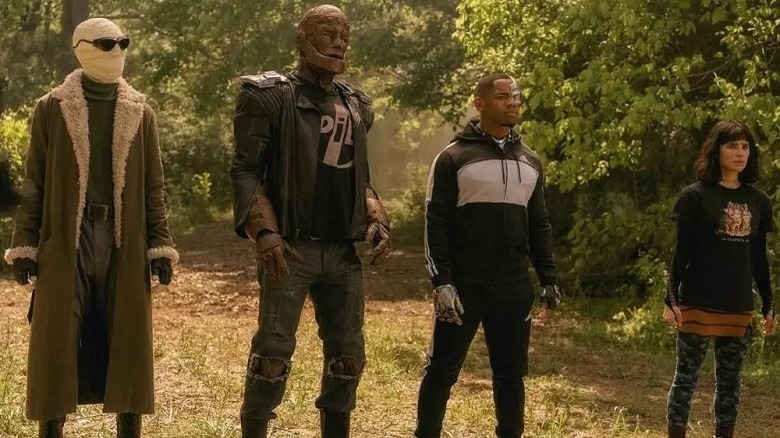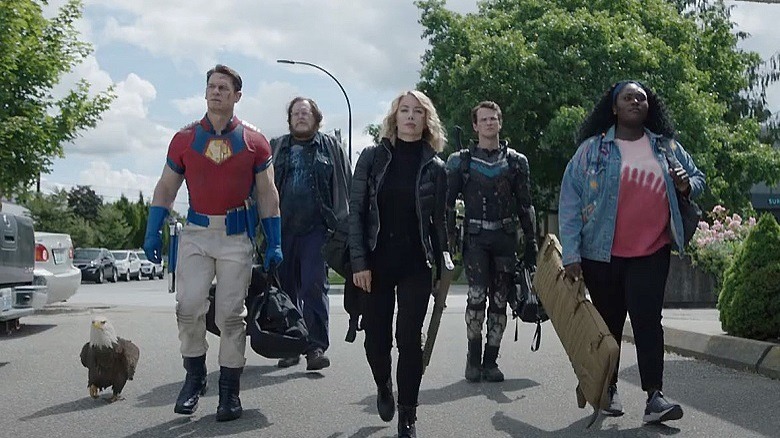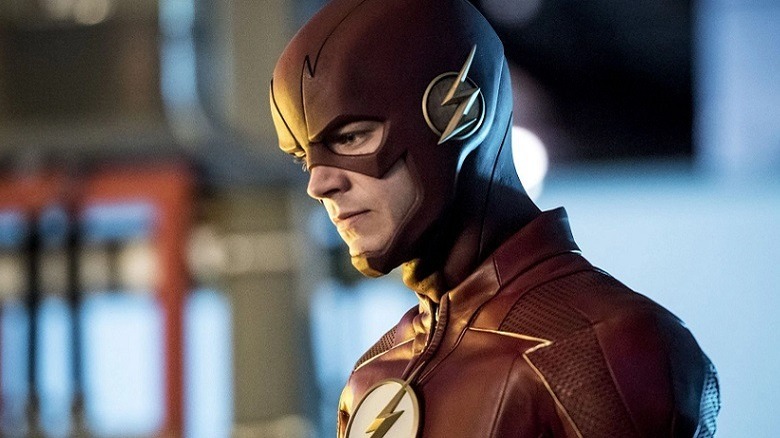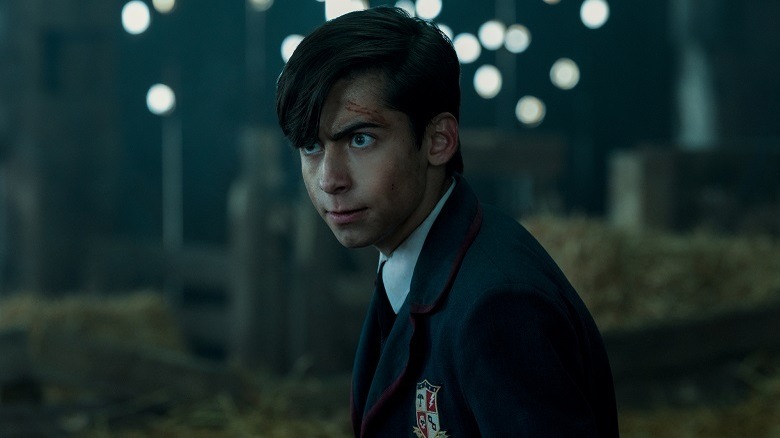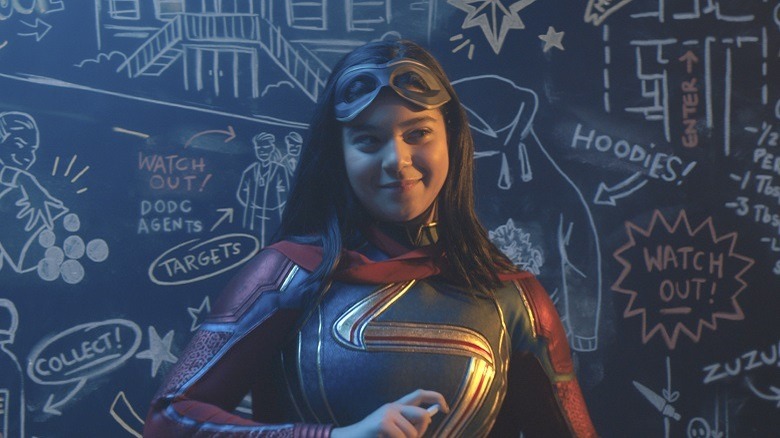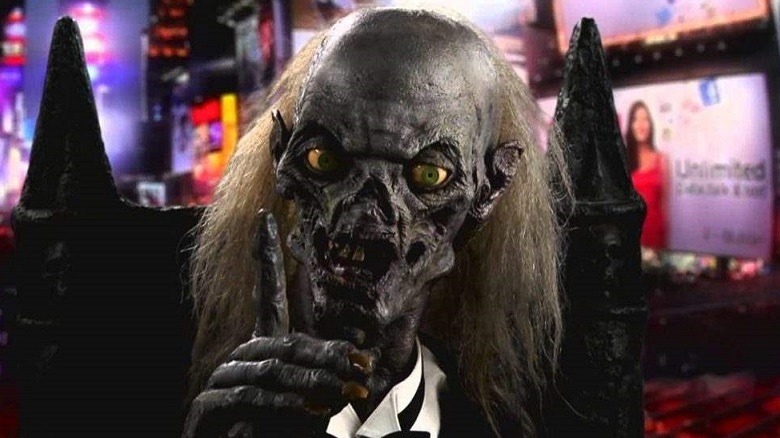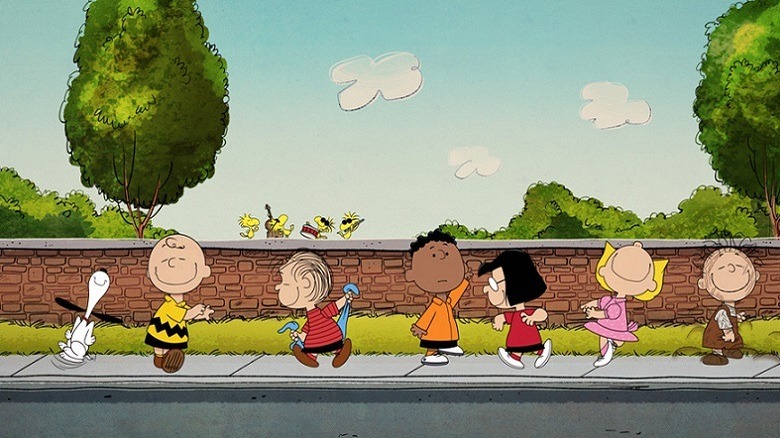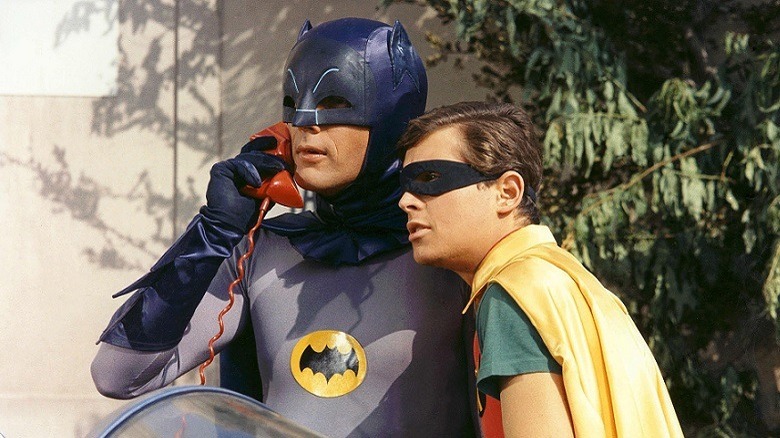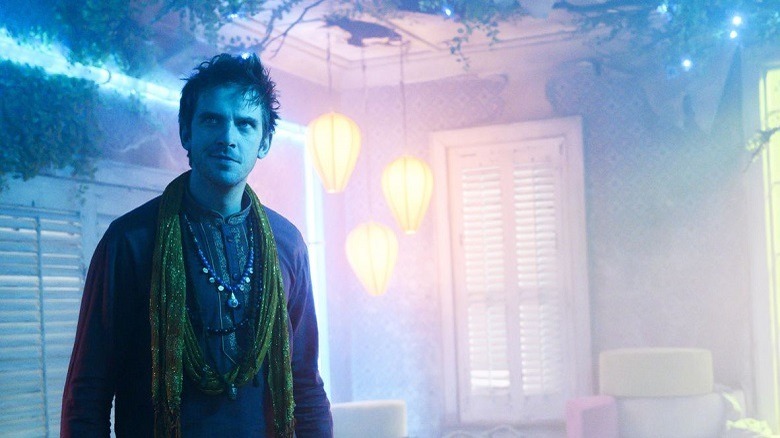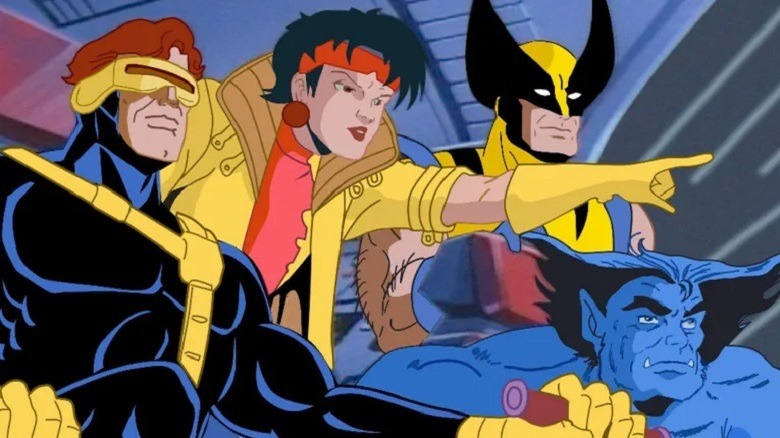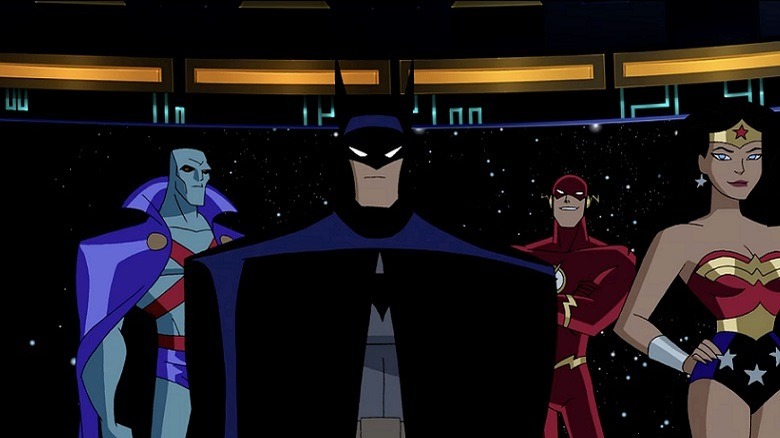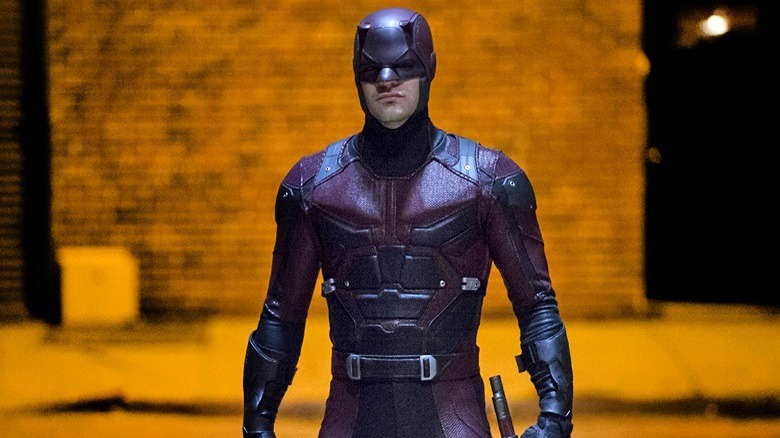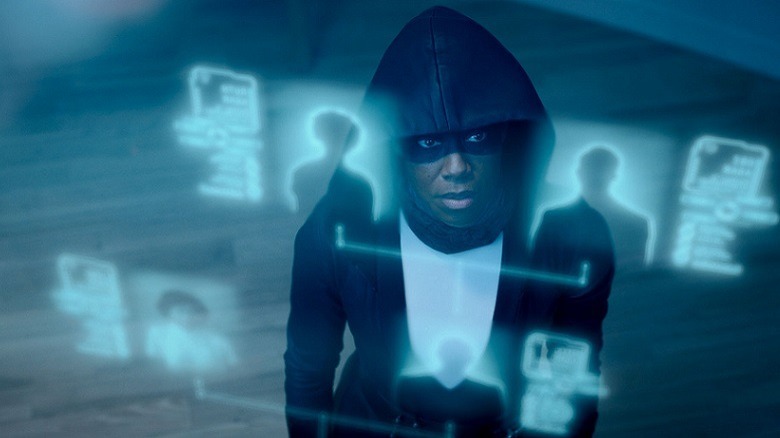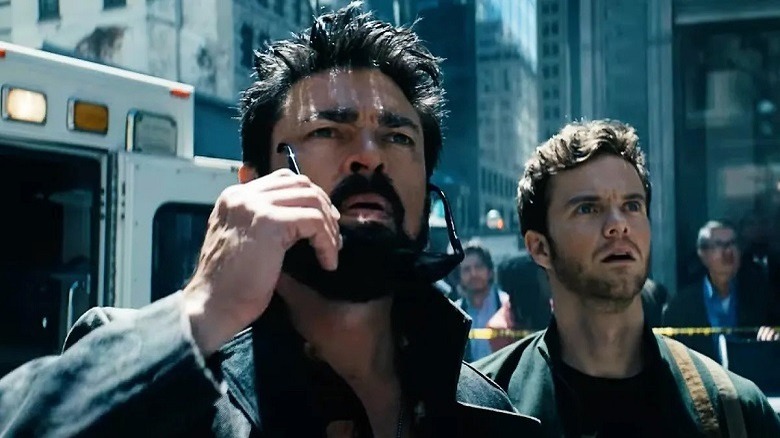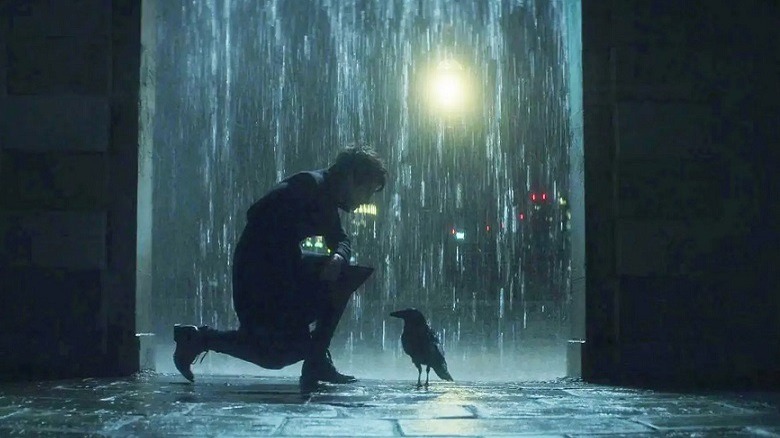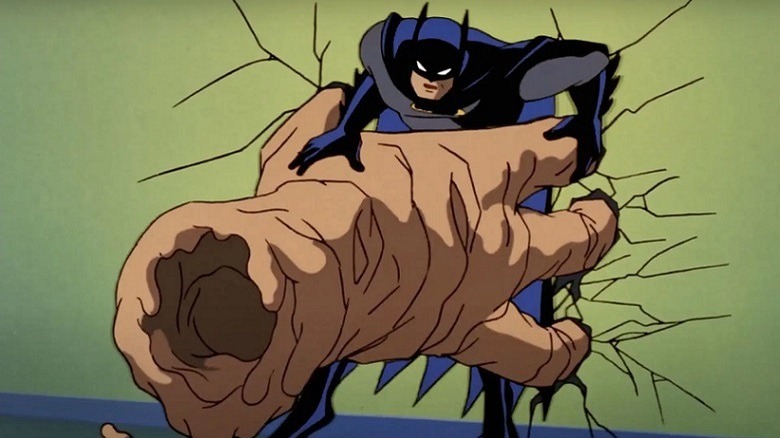The 18 Best TV Shows Based On Comic Books, Ranked
In theory, producing a television series based on an existing comic or a comic strip should be easy. The storyboards are all done for you, right? That's until you realize that what took an artist a day to draw (that only cost them paper, ink, and copious amounts of coffee) might be impossible to commit to the screen without a budget matching a small country's gross domestic product.
That said, there is certainly no shortage of attempts, and with the increasing availability and affordability of CGI, it's easier to convey an artist's ambitious and mind-blowing visuals than ever before. From barrel-chested George Reeves' first portrayal of the Man of Steel in 1952's "The Adventures of Superman" to Lewis Wilson donning the familiar (yet excessively pointy-eared) cowl of Batman in the 1943 serial "The Batman," many familiar characters have made the leap from page to screen.
In an excessively crowded market, the list of such shows is in constant flux, but this is an attempt to rank the best of the best. There may be some you didn't realize originated from the page, and some that aren't even (gasp) shows about superheroes, but they're all pretty darned good and worthy of a slot in your TV watching schedule.
18. The Addams Family
The mysterious and spooky Addams Family first appeared on the pages of The New Yorker in 1938. New Jersey-born cartoonist Charles Addams conjured them from his love for the macabre, and the (mostly) unnamed bizarre family members from this twisted household would eventually be given their own television show in 1964 — oddly, released in the same week as the thematically similar "The Munsters."
A situation comedy following the lives of the ghoulish inhabitants of 001 Cemetery Lane, it ran for two seasons. Featuring the tried and tested sitcom premise of the fish-out-of-water, much of the series humor derives from the Addams family's frustrations at dealing with the outside world — and the way the outside world is terrified of these creepy kooks, regardless of their good intentions.
Vampish mother Morticia and patriarchal Gomez Addams head the family, and Wednesday and Pugsley are their children. An assortment of motley characters composes the remainder of the clan, including the sentient severed hand known as Thing, and the behemothic butler, Lurch. Actor John Astin was given a choice of his character's name from creator Charles Addams when it was adapted for TV. He shunned Repelli in favor of Gomez. Despite their odd outward experience, they're a tight-knit family unit, and you'll struggle to find a greater love story on television than that of Gomez and Morticia.
17. The Tick
Created as a mascot for the New England Comics retail chain, the mighty mite-themed marvel first appeared in his own title in 1988. A satire on superhero culture, "The Tick" follows the eponymous azure arachnid avenger and his sidekick, Arthur, and their attempts to keep the city (known only as "The City") safe.
Moving from comic to animated cartoon in 1994 and then live-action series in the 2000s, the central premise is that the Tick is a childish buffoon, eager to impress and armed with a vastly exaggerated opinion of his abilities. Charging into battle with the war cry "Spoon!" (inspired by the cutlery, it was a necessary replacement for his old war cry of "Not in the face! Not in the face!") the Tick and Arthur face a bizarre rogues gallery of supervillains.
The Hotel Manager, Eastern Bloc Robot Cowboy, and Breadmaster all have faced two-fisted justice at the hands of the Tick, but they fade into insignificance next to the heinousness of Chairface Chippendale. The appropriately named (because his head is a small chair) Chairface is the Tick's biggest foe — and is just as insane as his spandex sporting nemesis. Regardless of format, "The Tick" is an irreverent, hilarious love letter to superheroes as well as a thorough roasting of an inherently silly concept.
16. Doom Patrol
First appearing on the shelves in 1963, the comic "Doom Patrol" tells the saga of the unlikeliest of superhero groups: a disparate team of eccentric misfits, all of whom received their powers through unfortunate circumstances and accidents. Shunned by a society that fears them, they protect us from the existential threats that other superheroes dare not face.
While the Justice League is confronting intergalactic despots and mind-controlling Asteroidea, the Doom Patrol is repelling sentient shadows, the fifth horseman of the apocalypse, and assassins who eat facial hair. The comic itself has undergone a number of revamps, with the last series written by Gerard Way.
There was a doubt whether any TV show could quite pull off the quirkiness and surrealistic nature of the comics — especially the Grant Morrison run — but fans were quickly placated by the first season. It's gone from strength to strength, nicely building up its own mythology as effectively as it has done absorbing material from the comics. It'd be too easy to label such a bizarre show as silly, but it has a surprising amount of heart and pathos. It's hard not to feel for our ensemble of outcasts and their struggles to keep themselves —and the very world itself — sane.
15. Peacemaker
Peacemaker made his comics debut back in 1966 in the pages of "Fightin' Five" #40 and was eventually incorporated into the DC Universe in 1985. Following John Cena's scene-stealing performance as the patriotic one-man arsenal in "Suicide Squad," a show featuring the character was announced. It would be the first television series from the DC Expanded Universe.
In the more-than-capable hands of James Gunn, "Peacemaker" was never going to be a straight superhero show, and that much is obvious from the opening credits alone. Beginning with the cast engaging in a choreographed dance routine, a novel start that other shows might consider adopting — "Peacemaker" sets its stall from the outset, and marked it as that rarest of shows where you'll never hit "skip intro." A far cry from the relentlessly murky grimness of the Snyderverse, this show proudly proclaims that it will not be serious.
Despite what the title would suggest, this is an ensemble show in which Peacemaker (fresh out of prison following his regretful actions in "Suicide Squad") is forced to team up with a black ops team to take out an alien threat. It's brutally violent, with near-the-knuckle humor, and is exactly what you'd expect from the writer-director that brought you "Super" and "Slither." Long since having outgrown his wrestling reputation, John Cena is a revelation.
14. The Flash
In 1940, the tin-helmeted, turbocharged hero first burst out of the Speed Force and onto the pages of All-American Publications' "Flash Comics" #1. When the publisher merged with DC Comics, this particular Flash, Jay Garrick, was one of the founding members of the Justice Society of America. Barry Allen was the second man to take the title of "The Flash," adopting the role of the Scarlet Speedster in 1956.
There was a perfectly adequate TV series (starring John Wesley Shipp as Barry) released in 1990, but here we're concentrating on the series that aired on The CW in 2014. Alongside "Arrow," "Supergirl," and "Legends of Tomorrow," it's one of many strong titles on that network but edges out the others due to longevity and how perfectly it captures the style of the comic.
For a series about running, though, it could be argued that "The Flash" has run its course. Like any series that runs for so long, it's become a victim of diminishing returns. It struggles at times to keep up with the sheer number of superhumans who now inhabit the crowed confines of fictional Central City, but at the height of its popularity, it was immense fun, with enough twists and turns to propel each season along. Flash actor Grant Gustin relishes every minute spent in that suit, and his enthusiasm is enough to boost even the most workmanlike of storylines.
13. The Umbrella Academy
"The Umbrella Academy" comic began in 2007, published by Dark Horse Comics. The second ever comic script by "My Chemical Romance" lead singer Gerard Way, the first issue went on to sell out, and the first collection went on to win the coveted Eisner award in 2008 for Best Limited Series.
"The Umbrella Academy" was a superhero team comprised of children, each born to different mothers who, in Midwich Cuckoo style, exhibited no sign of pregnancy. Each child possessed quite different powers and abilities — or seemingly none at all. Both the comic and television series see the old academists return home some years later upon learning of the death of their patron.
It's an aspect rarely explored in superhero fiction, the post-metahuman career after the heroic days are over — after the fame, fortune, and glory have long since evaporated. They find themselves forced to band together again to fight a common foe but only reluctantly. They're not relatives, after all — they're bound together only by a common cause as opposed to blood, and many of them have spent the years apart, growing in resentment. A show boosted by an excellent central cast, including the ever-excellent Robert Sheehan as Klaus, an actor who'd previously cut his superhero teeth in the excellent UK Channel 4 superhero show "Misfits."
12. Ms. Marvel
There's an alternate reality where Marvel didn't have the success they've achieved, and the budget never existed to take risks. "Ant-Man" and "Thor: Ragnarok" never happened, with no producers willing to invest in what were effectively comedies, and "Black Panther" and "Captain Marvel" were an absolute no-no — stories centered around PoC and a woman? What next? Whatever you think of the Marvel Cinematic Universe, its success was earned (kickstarted by an obscure character, barely known outside comic circles in Iron Man, at that), and it's worked wonders for both their cinematic and television output.
Kamala Khan debuted in 2013 in the pages of "Captain Marvel" #14 (where else?) and moved to her own comic in 2014, becoming Marvel's first Muslim character with their own title.
There's a great deal of thematic variety in the Marvel television output so far, from magical sitcom pastiche to espionage to reality-hopping multiversal shenanigans. "Ms. Marvel" is a delight. It's an origin story of sorts, but it's difficult not to be thoroughly charmed by both the joyful innocence and enthusiasm of the lead (a perfectly cast Iman Vellani), creative production design, and innovative storytelling techniques. "Ms. Marvel" is a show that will make you grin from ear to ear and is a worthy vehicle for this groundbreaking hero.
11. Tales From the Crypt
The horror comic anthology "Tales from the Crypt" was published between 1950 and 1955, but the introduction of the restrictive Comics Code, created to combat the threat of juvenile delinquency, saw the EC comic and its sister titles canceled. Amicus productions made a successful portmanteau feature film based on five stories from the comics in 1972, but it wasn't until 1989 that the television series first appeared on our screens.
A jaunty Danny Elfman theme set the scene, catapulting the viewer through an old house and towards the cobweb-strewn crypt where the host would burst from his grave. Introduced by the gaunt and ghoulish form of the cackling Cryptkeeper (who was no stranger to a macabre pun) each episode was a short horror film, traditionally involving stories of grisly justice that saw ne'er-do-wells meeting gruesome and deserved ends. Lasting 93 episodes over seven seasons, the quality control remained high. Interestingly, almost every episode was directly lifted from the fifties comic book pages — albeit with the nudity and gore dialed up.
A plethora of guest stars, including Arnold Schwarzenegger, Patricia Arquette, Tom Hanks, and Brad Pitt featured in these fiendish fables. It would also go on to spawn several movies and cartoon spinoffs, the series proving itself as difficult to kill as the specters which haunted many of its stories. Check out some episodes ... boils and ghouls!
10. The Snoopy Show
The double-bill of Charlie Brown and his faithful (and odd) beagle, Snoopy, is such a worldwide cultural phenomenon that there are (probably) lost tribes hidden in the deepest depths of the jungle that would recognize the image of the round-faced child and his smirking becollared dog. Charlie Brown (in name only) first appeared in creator Charles M. Schulz's strip "Lil' Folks" in 1948, However, he wouldn't make his proper debut until the strip was renamed "Peanuts" in 1950. Snoopy appeared two days later.
A comical tale of the trials and tribulations of childhood life, "Peanuts" made its first TV appearance in 1965 with the animated holiday special "A Charlie Brown Christmas." More successful holiday specials, a short-lived Saturday morning cartoon called "The Charlie Brown and Snoopy Show," and the computer-animated feature "The Peanuts Movie" followed.
In 2021, Apple TV+ brought the Peanuts back to the small screen with "The Snoopy Show." It's a nostalgic throwback to a more innocent time in which apart from the (often literal) flights of fancy of a daydreaming Snoopy and his avian accomplice, Woodstock, it sees our diverse cast pondering youthful existence. Adults never feature, apart from the unintelligible trombone sounds of their voices, but the children are treated with a surprising level of maturity. As a child, you can appreciate the show for its funny dog and slapstick humor. However, adults will enjoy the surprisingly deep philosophizing of the central cast.
9. Batman
With every attempt to depict the Caped Crusader, be it animated or live-action, every incarnation seems insistent on being grittier and darker than the last. To that end, it's at times difficult to reconcile the Batman of today with the one that Adam West portrayed back in 1966. And they all seem worlds apart from the Guardian of Gotham's first appearance in the pages of "Detective Comics" back in May of 1939.
This was a gaudy and colorful "Batman" that's closer in style to the work of co-creators Bob Kane and Bill Finger than the Dick Sprang and Carmine Infantino aesthetic of the comic from the '60s. Cornier than the Jolly Green Giant and as camp as a row of tents, it was a tremendous success and introduced a mainstream audience to the Defender of Gotham and his brightly attired Boy Wonder. Featuring a host of stars either guesting as the villain of the week or making cameos through a window on a building our dynamic duo was scaling, it's hard to appreciate how much of an impact the show made on pop culture.
What was its secret? It could be argued that it was Adam West himself taking the odd yet effective approach of playing this silly character with deadly seriousness. In a show that was a light-hearted comedy, Batman remained the rock-solid core of reliability, a pivotal anchor preventing the whole show from spinning off into total parody.
8. Legion
After being diagnosed with schizophrenia at an early age, the only homes that David Haller has ever known are psychiatric hospitals. A chance encounter sews the seeds of his doubt in his ravaged mind. What if his mental illness is in actuality a superpower? This leads him into conflict with the mysterious forces of Division 3 and into the safekeeping of an equally mysterious group of mutants.
The character of David Haller, given the biblical name Legion in the comics for the multiple personalities caused by his disorder, first appeared in the pages of "New Mutants" in 1983, created by Chris Claremont and Bill Sienkiewicz. Dan Stevens of "Downton Abbey" and "The Guest" plays the title role in the series that ran for three seasons beginning in 2017.
"Legion" is a standout show. It's refreshing to see a television show handle mental illness appropriately and with respect, and it's also good to see a superhero tale veer away from many of the traditions associated with the genre. "Legion" isn't afraid to confuse the viewer with both an unreliable narrator and wildly tangential plot shifts. It's a show that rewards your concentration. There weren't any shows like "Legion" before, and there haven't really been any since. The Marvel (but not MCU) setting places it in a vaguely recognizable yet unfamiliar world, and this is one of the show's core strengths.
7. X-Men: The Animated Series
There was no shortage of Marvel cartoons in the 1990s, with many of their primary hero roster (Spiderman, Iron Man, The Hulk, and Fantastic Four) all vying for our Saturday morning attention. However, one cartoon stood above them all, outlasting the others by several seasons. "X-Men: The Animated Series" remains one of the best comic book cartoons ever made.
The menagerie of mutated marvels may have formed in "X-Men" # 1 back in 1963, but the five-season run of "X-Men: The Animated Series" began in 1992 on the Fox Kids Network. Following the exploits of the mutant superhero team led by Professor Charlies Xavier, it would see our coterie of chromosomally challenged champions fight not just super-villains but prejudice and bigotry from humankind that feared them.
It was a series that was never afraid to deal with more mature themes with storylines featuring religion and the Holocaust. Tales were also given time enough to breathe, often spanning multiple episodes. Many of the better-known and acclaimed comic storylines were given the cartoon treatment, too, with "Days of Future Past" being a particular highlight. It also got the acclaimed and epic "Phoenix Saga" right, whereas two multi-million dollar live-action movies ( "X-Men: The Last Stand" and "X-Men: Dark Phoenix") struggled to do it justice. Satisfying many fans who feel that Marvel cartoons have struggled to hit the same heights, Marvel is reviving the series as "X-Men '97" for release in 2023.
6. Justice League and Justice League Unlimited
The original Justice League formed in "The Brave and the Bold" #28 back in March 1960. However, writer Grant Morrison was tasked with revamping the Justice League of America in 1996, merging the several offshoot titles into a cohesive whole and removing much of the humor that had marked the last incarnation as a more light-hearted title. This "Justice League," which brought all the big players back into the fold, including Superman, Batman, and Wonder Woman, would now fight Earth or Cosmos-endangering threats worthy of their powers.
Morrison equated the JLA to being alike to a pantheon of gods, and it was his incarnation of the league that would come to cartoon life in the animated series "Justice League" and "Justice League Unlimited." Kevin Conroy returned as Batman, having already established himself as the definitive voice of the Dark Knight in his own animated series, and the series featured a plethora of other voice talents, including Michael Rosenbaum as the Flash (who DC fans would recognize as Lex Luthor in "Smallville") and the dulcet tones of character actor Clancy Brown as Lex himself.
The stories were well-written and often spanned multiple episodes, allowing for greater plot and character depth than cartoons ordinarily allowed. The show wasn't afraid to use obscure villains, and even long-overlooked DC hero Martian Manhunter was finally given something decent to do. To top it all, there was just enough humor to stop it from descending into ponderousness. When DC gets the animated output right, they get it very right.
5. Daredevil
Comics legend Stan Lee reveled in creating flawed characters. From the shunned mutants of the X-Men and the alcoholism of Tony Stark to the teenage woes of Peter Parker, each hero is imbued with a level of depth sadly missing from the comics industry at the time. "Daredevil," released in 1964, is no exception. Matt Murdock might not have been the first blind superhero (that honor goes to DC's Doctor Mid-nite), but he is certainly the most well-known. However, it wasn't until the Frank Miller and Klaus Janson run on the title in the '80s that the character became huge, and it's this gritty, noir variant on the Man Without Fear that evolved into the Marvel TV series.
Blinded by a chemical spill as a child, it was that same toxic soup that heightened the remainder of Matt Murdock's senses. Gifted with extraordinary spatial awareness, Matt would go on to fight crime as an attorney-at-law by day and a crime-fighting vigilante by night.
Instantly banishing the memories of the "Daredevil" film (and the even worse pseudo-sequel featuring the assassin Elektra), the Netflix TV series was a triumph. Giving us an utterly convincing and menacing Kingpin in the form of Vincent D'Onofrio, it would live on for three seasons with Charlie Cox's Matt Murdock eventually winding his way into the main Marvel Cinematic Universe.
4. Watchmen
In a world where a series can outstay its welcome, hanging around like a zombie on life-support (I'm looking at you, "Lost" and "The Walking Dead"), it's refreshing that a show can still be designed to stand alone.
"Watchmen," released in 2019, is one such series, Designed as a follow-up to the comics and not the 2009 Zack Snyder movie, "Watchmen" had a lot to live up to. It's not hyperbole to state that the seminal 1986 series by Alan Moore and Dave Gibbon redefined comics, showing us what the medium is capable of.
How do you follow that? Set it in the same world, but contemporize the themes. On the release of the graphic novel, the Cold War was at the forefront of the world's psyche. Interlinking that with themes of justice and retribution, it hit the zeitgeist. Sister Night (Regina King) is the star of this TV series, and the ever-present themes of justice still run through it. However, they're seen through the eyes of its Black protagonist, allowing the series to explore the topical themes of racial tension in America. It's whip-smart, with an array of interestingly fleshed-out characters. And critically, it is educational. The Tulsa race massacre features heavily in the story's time-spanning plot, a American tragedy many viewers around the world may be unaware of.
3. The Boys
"The Boys" #1 was published by DC on their WildStorm imprint back in 2006 but was canceled by Issue #6. Uncomfortable with the anti-superhero nature of the title, they returned the rights to Garth Ennis and Darick Robertson, and the title found a new home with Dynamite Entertainment. How Garth's hatred of superheroes (his protagonists in his runs on "Hitman" and "Punisher" gleefully slaughtered them by the dozens) came as a surprise to DC is a mystery. At Dynamite, "The Boys" went from strength to strength, eventually concluding after a long run to be adapted into a successful TV series.
Billie Butcher, a hero-hating psychotic, leads a team known as "The Boys." This motley crew of cape killers hunts down vigilante heroes in a world where superpowers are rife. Hughie Campbell (based on Simon Pegg in the comic, so it was a nice touch when the actor played his father) becomes a reluctant recruit for the group after the love of his life is accidentally killed by a superhuman.
Readers familiar with the comics must have thought that the TV equivalent would have had to be toned down due to the excessive graphic violence on the page. Their concerns were unfounded. It's as violent and curse-filled as the source material and is all the better for its brutal approach.
2. The Sandman
Considering that adaptations of Neil Gaiman's "The Sandman" had passed through development hell more times than its protagonist, Morpheus, has passed through actual hell, it was a surprise that this ever got made. Fans needn't have worried. It was well worth the wait.
The original comic series ran for 75 issues between 1989 and 1996 and was a huge success. Pushing the boundaries of comic storytelling, it's an ambitious tale of ancient beings and their interactions with humanity. Lead protagonist Morpheus (Tom Sturridge) finds himself captured by mankind for selfish purposes and upon his escape, finds that even he is capable of evolution and change.
Neil Gaiman has had great success with television adaptations of his tales before, notably with "Good Omens", co-authored with Terry Pratchett, and it's accurate to say that the television series is as close to realizing his ambitious vision as it could be. With Neil Gaiman having rejected so many attempts to make this seminal work, it's a relief that the finished article feels like such an elegant transition from page to screen. Perfectly cast, it's a refreshing deviation from the superhero trope into a well-rounded, self-contained mythology. The comics were rooted in the DC Universe, featuring cameos from the likes of Martian Manhunter and Wesley Dodds, the 1939 vigilante who shared the name Sandman. However, the series' departure from that has served it well. Here's hoping for a second season.
1. Batman: The Animated Series
With 1989's "Batman," Tim Burton and Michael Keaton brushed away the memories of the camp 1960s television series, but in 1992's "Batman: The Animated Series," show creator Bruce Timm excised them forever. Beginning with the familiar Danny Elfman theme, the opening scenes made it very clear the kind of cartoon show this would be. From the art-deco architecture of Gotham that was simultaneously archaic and modern with its moon and gas-lit streets to the distinctive square-jawed style of the noir-esque characters, this was a truly dark Dark Knight.
The art style, lighting, and general look of the show were distinctive at the time. Reminiscent of Fleischer Studios' animated take on Superman in the 1940s, the show is recognizable from just a single frame. It was also elevated by a plethora of voice talent, with gravel-voiced Kevin Conroy delivering a pitch-perfect level of gravitas to the character. Mark Hamill would also go on to voice the greatest and most sinister Joker ever put to screen.
"Batman: The Animated Series" lasted for a total of 85 episodess, spinning off into several successful movies. A mixture of original stories and tales adapted from the various Batman comics, it continues to be as amazing a series now as it was then, and the timeless animation style is still seen across a variety of DC animated projects. It remains the definite take on the Dark Knight, with not a "Biff!" or "Kapow!" to be seen.
